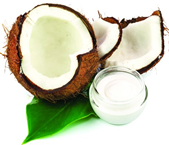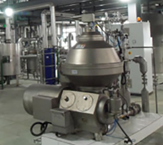It is popular among the world to say that there is a use for the coconut palm in every day of the year. Indeed, coconuts can be processed into many products. The coconut kernel and water are two edible parts which form the basic ingredient for a variety of coconut products.
It is popular among the world to say that there is a use for the coconut palm in every day of the year. Indeed, coconuts can be processed into many products. The coconut kernel and water are two edible parts which form the basic ingredient for a variety of coconut products.
Coconut water is a refreshing and cooling drink. Its sodium and potassium content makes it an ideal drink for rehydration. In a healthy, undamaged coconut, the water is even sterile.
Coconut water is a refreshing and cooling drink. Its sodium and potassium content makes it an ideal drink for rehydration. In a healthy, undamaged coconut, the water is even sterile. Fresh coconut after dehusking and deshelling, then use one needle to pierce one hole on the coconut to extract coconut water. After extraction, coconut water is filtered. Filtration can be done using a double cloth filter. This is especially important for mature coconut water, as dry husk fibres and dirt from the shell of mature nuts can easily get into the coconut water during extraction. After filtration, the coconut water is quickly cooled to retard any deterioration reactions. Then, it is sent for separation, homogenizing, degassing, subsequent pasteurization and aseptic packaging.
If coconut water is extracted at a location away from the aseptic packaging site, the filtered coconut water can be packed into food grade plastic bags, quickly cooled and transported to downstream processing. The single strength coconut water content is 92%-95% and soluble solids is about 12 brix.
Concentrated coconut water: Concentrated coconut water is about 60-65 brix and water content is about 35%-40%. Fresh coconut water after extracting, filtering, cooled to 4 ℃ and storing into double layers insulation tanks. Then the low-temperature coconut water will be pre-pasteurization and separation. Then, it goes into a multiple-effect evaporation stage to increase °Brix levels. Usually, the product is concentrated to 60-65 °Brix and packed into 200 kg plastic bags in drums for bulk transportation under ambient conditions. It is recommended that the concentrate coconut water will be stored at below zero temperature for 2 years.
Coconut milk and cream is produced from 10-13 months old mature coconuts when the kernel is hard and thick.
Coconut milk/cream: Coconut milk and cream are produced from 10-13 months old mature coconuts when the kernel is hard and thick. They are natural oil-in-water emulsions extracted from the mature coconut kernel. The difference between coconut milk and cream is the amount of fat. The fat content of the coconut milk is 5%-20%, whereas coconut cream reaches to 20%-50%. To extract coconut milk for industrial manufacturing purposes, mature coconuts go through deshelling and paring. Pieces of kernels are then sent into industrial-scale cutters and grinders. Next, the grated coconut kernel then goes into a series of screw extractors to extract coconut milk. The residual kernel from this first press is then mixed with water before it is pressed again to increase extraction yield. After extraction, coconut milk is filtered by a vibrating sieve machine to remove large contaminants. It can then be standardized to a pre-determined level of fat and blended with other ingredients. Finally, coconut milk is homogenized, degassed, pasteurized, and aseptically filled into aseptic bags or small packages like bottles or tin cans.
Coconut oil is one of the main products traditionally derived from the coconut kernel. It is a mixture of chemical compounds called triglycerides that are compounds made up of fatty acids and glycerol. Coconut oil is rich in saturated fatty acids and low in unsaturated fatty acids. The different fatty acids present in coconut can range from C6-C18 carbon atom chains.
Coconut oil: Coconut oil is one of the main products traditionally derived from the coconut kernel. Coconut oil processing methods or technologies are classified into two major types based on copra or fresh coconut kernel used. The oil extraction technology, which starts with copra as the raw material, is commonly known as the dry process. While the method that uses fresh coconuts as starting material is generally called the fresh-wet or fresh-dry process. Based on different separation methods, coconut oil can be classified into two types – RBD coconut oil and virgin coconut oil (VCO). The former is refined, bleached and deodorized (RBD) from dry extraction, while the latter is produced by fresh-wet and fresh-dry extractions.
Coconut milk production process with modern technology UHT pasteurization
UHT technology (Ultra High Temperature) is a high temperature liquid process (140-144 ° C) for 4 seconds and then cooled down. UHT technology is capable of ultra-high heat treatment and ultra-fast cooling to kill off harmful bacteria while retaining the maximum nutrients and natural flavor of coconut milk.
Detailed steps in Coconut Milk Coconut Production Process:
Coconut fruit (Organic / Non-Organic) → Fiber and water
Coconut water will be put into the receiving tank → First filter to remove residue → Coconut water through the filtration process will be cooled at temperatures less than 4oC
Mixture through centrifugal technology → Absolute paste → Continue to be cooled at a temperature less than 4oC → Pass past Past tank / Blending tank and start mixing coconut milk
Filtered mixture 2 → Direct sterilization with UHT technology → Cooling mixture → Transfer through Sterile Tank
Sterilization → Lid, cans → Finish: coconut milk





Coconut plant technical parameters
Capacity | From 50KG/Hour up to 10,000 KG/Hour |
Plant Automation Level | Manual, Semi-Automatic, Automatic, MES |
Products | Coconut Water, Coconut Oil, VCO, Coconut Milk, Coconut Cream, Coconut Powder etc. |
Product package | Tin Can, PET, Carton, Pouch and Drum etc. |
Contact: Foster
Phone: 0086-18616029030
E-mail: sales@oregenpak.com
Add: Jiading Zone, Shanghai, P.R.C